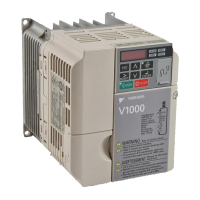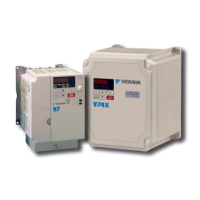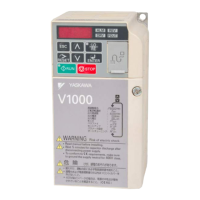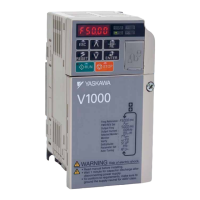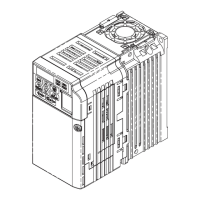u
b8: Energy Saving
The Energy Saving feature improves overall system operating efficiency by operating the motor at its most efficient level. This is accomplished by
continuously monitoring the motor load and adjusting the motor terminal voltage so that the motor always operates near its rated slip frequency. A motor
is most efficient when operating near rated slip conditions.
Note: Energy Saving is not appropriate for applications where the load may suddenly increase. Such applications should use derated torque.
n
b8-01: Energy Saving Control Selection
Enables the Energy Saving feature.
No. Parameter Name Setting Range Default
b8-01 Energy Saving Control Selection
0: Disabled
1: Enabled
0
n
b8-02: Energy Saving Gain (requires Open Loop Vector)
The output voltage during Energy Saving operation is the product of the normal V/f settings (E1-03 to E1-13) and the Energy Saving gain. The output
voltage decreases and recovers according to the Energy Saving control filter time constant b8-03. As the Energy Saving gain increases, the output voltage
increases also.
No. Parameter Name Setting Range Default
b8-02 Energy Saving Gain 0.00 to 10.0 0.7
n
b8-03: Energy Saving Control Filter Time Constant (requires Open Loop Vector)
Parameter b8-03 sets the response time for Energy Saving. Although lowering this value allows for a quicker response, instability may result if it is too
low.
No. Parameter Name Setting Range Default
b8-03 Energy Saving Control Filter Time Constant 0.00 to 10.00 Determined by o2-04
n
b8-04: Energy Saving Coefficient Value (V/f Control)
Parameter b8-04 is used to maximize motor efficiency. The default setting depends on the capacity of the drive, but can be adjusted in small amounts
while viewing the kW monitor (U1-08) and running the drive to minimize the output kW.
A larger value typically results in less voltage to the motor and less energy consumption, but too large a value will cause the motor to stall.
No. Parameter Name Setting Range Default
b8-04 Energy Saving Coefficient Value 0.00 to 655.00 Determined by o2-04 and E2-11
Note: This default value changes if the motor rated capacity set to E2-11 is changed. The Energy Saving coefficient is set automatically when Energy Saving Auto-Tuning is performed
(see the section on Auto-Tuning).
n
b8-05: Power Detection Filter Time (requires V/f Control)
The Energy Saving function will search out the lowest output voltage in order to achieve minimum output power usage. Parameter b8-05 determines how
often the output power (kW) is measured and the output voltage is adjusted.
No. Parameter Name Setting Range Default
b8-05 Power Detection Filter Time 0 to 2000 20 ms
n
b8-06: Search Operation Voltage Limit (V/f Control)
Once Energy Savings is enabled and the optimal energy saving coefficient value has been set, the programmer can have the drive further search out the
proper voltage to achieve the lowest output power by measuring the output power and making minute changes to the output voltage.
No. Parameter Name Setting Range Default
b8-06 Search Operation Voltage Limit 0 to 100 0%
Detailed Description
Limits the output voltage to make sure that the output power stays just above the minimum value.
Note: If set too high, the motor may stall with a sudden increase to the load. Disabled when b8-06 = 0. Setting this value to 0 does not disable Energy Saving.
Related Parameters
No. Parameter Name Setting Range Default
E2-02
*3
Motor Rated Slip 0.00 to 20.00
*1
E2-11
*2
Motor Rated Capacity 0.00 to 650.00 kW
*1
*1. Default setting is determined by drive capacity (o2-04).
*2. Automatically set when Auto-Tuning is performed.
*3. Automatically set when Rotational Auto-Tuning is performed.
5.2 b: Setup
130
YASKAWA ELECTRIC SIEP C710606 18A YASKAWA AC Drive – V1000 Technical Manual (Preliminary)

